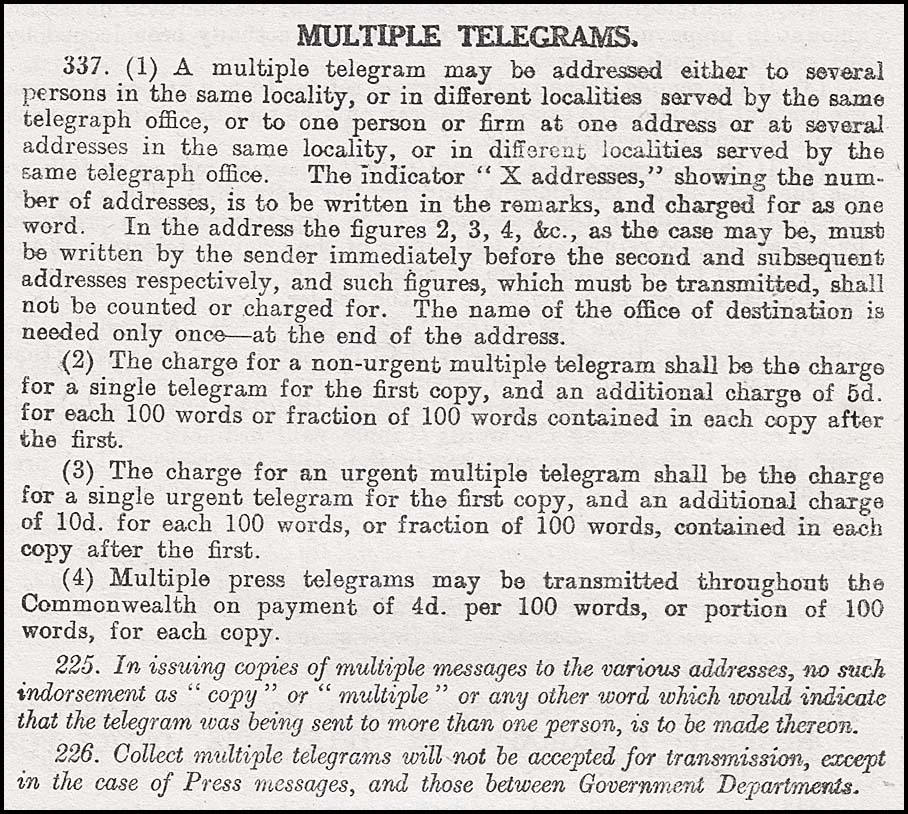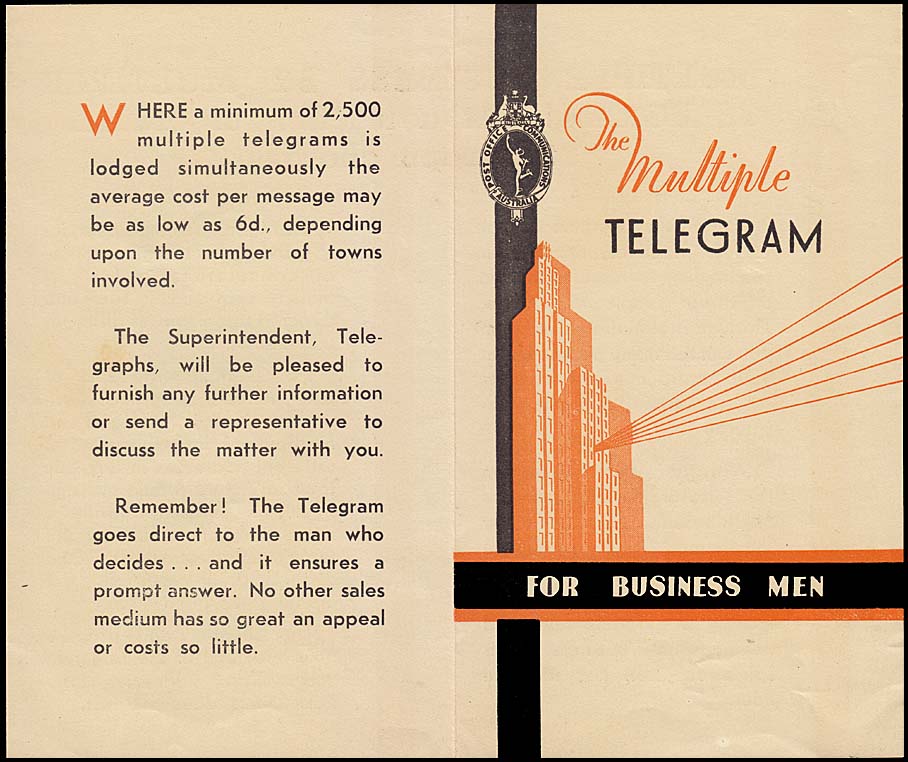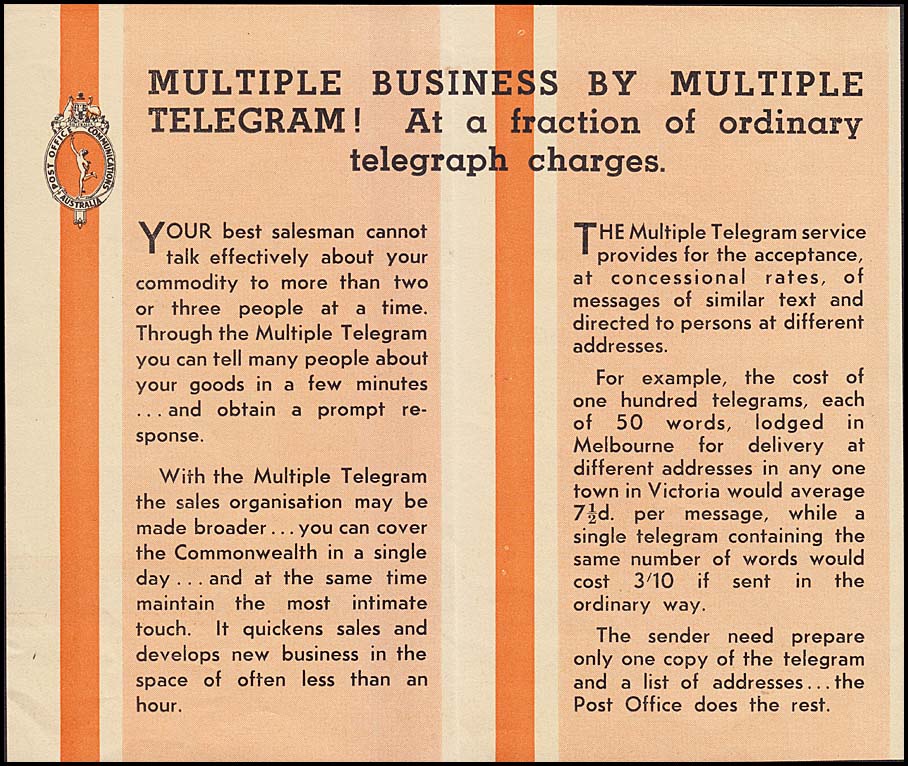Multiple telegrams.
- Home, index, site details
- Australia 1901-1988
- New South Wales
- Overview of NSW
- Telegraph lines
- Telegraph Offices
- Date stamps
- Forms
- Envelopes
- Rates
- Stamps
- Queensland
- Overview of Qld
- Telegraph lines
- Telegraph offices
- Date stamps
- Forms
- Envelopes
- Rates
- Stamps
- South Australia
- Overview of SA
- Telegraph lines
- Telegraph Offices
- Date stamps
- Forms
- Envelopes
- Rates
- Stamps
- Tasmania
- Overview of Tasmania
- General developments
- Reports
- Organisation
- Telegraph lines
- Telegraph Offices
- Date stamps
- Railway lines
- Forms
- Envelopes
- Rates
- Stamps
- Overview of Tasmania
- Victoria
- Overview of Vic.
- Telegraph lines
- Telegraph offices
- Date stamps
- Forms
- Envelopes
- Rates
- Stamps
- Ephemera
- Western Australia
- Overview of WA
- Telegraph lines
- Telegraph Offices
- Date stamps
- Forms
- Envelopes
- Rates
- Stamps
Multiple telegrams were a communication which especially facilitated commercial advertising. A single message could be sent to a large number of recipients. Alternatively a multiple telegram could be sent to several recipients to confirm sales, agreements or business strategies.
Multiple telegrams were not accepted for Europe via the Pacific cable or for places in North America via any route.
Then 1902 Commonwealth Gazette noted "Multiple telegrams may be sent to the same telegraph office, and shall be charged for as a single telegram with a further charge of half rate for each additional copy".
An article in the Hobart Mercury for 9 March 1904 argued about the methods of calculation to determine charges. It says: "As a curiosity of departmental calculation the following is interesting: The regulations prescribe that a multiple telegram shall be charged for as a single telegram with a further charge of half rate for each copy after the first with a minimum charge of 6d per copy. This sounds like a substantial concession; so it is for lengthy telegrams but if any one had to send the same telegram of say a dozen words in the message (with six on the address and one for signature) to half a dozen people in Launceston (each of them having six words in the address) it would cost him - if he availed himself of the concession of a multiple telegram - more than if, at six different times during the day, he gave the department the trouble of sending to and receiving at Launceston six separate telegrams of the same twelve words to the same six different persons".
The June 1922 Post and Telegraph Guide includes the following:
 |
From 1 May 1927, the regulations for charges for multiple telegrams were amended:
"The regulation in its new form provides that the charge for a non-urgent multiple telegram shall be the charge for a single telegram for the first copy and an additional charge of 5d. for each 50 words or fraction of 50 words contained in each copy after the first.
The charge for an urgent multiple telegram shall be the charge for a single urgent telegram for the first copy and an additional charge of l0d. for each 50 words, or fraction of 50 words contained in each copy after the first".
In 1929, another announcement noted "the low rate of 5d for every 50 words or portion thereof in each copy, the original, including the whole of the addresses being charged for at ordinary rates. There is no limit to the number of telegrams which can be sent under these conditions".
Another announcement reported in the Hobart Mercury of 26 August 1929 noted "The Postmaster-General believes that he has found a new way of increasing the revenue. By contract with firms who will send "multiple" telegrams, he believes he can help business firms in the city who wish to advise clients in the country of "a good thing" and at the same time acquire money for the revenue. One firm of tanners in the city sent 1,800 telegrams and drew its clients' attention to a splendid line at a special price. The result was a big increase of business. This should be an interesting experiment but, of course, it is open to abuse at the hands of unscrupulous firms".
By 1931, the Department were making annoncements such as the following: "Canvassing in other departments also had been successful. Fresh business in the despatch of catalogues had been obtained and the advantages of advertising by multiple telegrams and the collection of debts by telegram had been canvassed with success".
When the Commemorative Telegram form for the Opening of the Sydney Harbour Bridge was issue in 1932, a number of firms used that form to advertise their products or services.
By the end of 1932, the advertising became more focussed in its suggestions to businessmen:
"The use of the multiple telegram service - no carbon copies and each message is delivered as an original telegram for Christmas greetings, sales publicity and to move slow selling lines of goods. This service is large availed of in southern cities with most satisfactory results and its comparatively low cost. For seasonal greetings, it is cheaper than analmanac and produces a pleasant psychological effect on the recipient; it is a valuable adjunct to newspaper publicity and it will bring customers to your business. Two hundred and fifty telegrams, each of 16 words, for Cairns addressees would be approximately 7½d a message. Service on a given date could be guaranteed and the telegrams would be accepted before that date and held ready for delivery".
The Post Office advertised the facility widely in magazines and through small brochures which were displayed in Post Offices or delivered together with telegrams in the various delivery envelopes. The brochure had been made to fit exactly into these envelopes.
 Outside of an Australian Post Office brochure advertising Multiple Telegrams. Cover is the right half of the image to the right of the fold. The back page is to the left of the fold. |
 Inside of the above Australian Post Office brochure advertising Multiple Telegrams. |